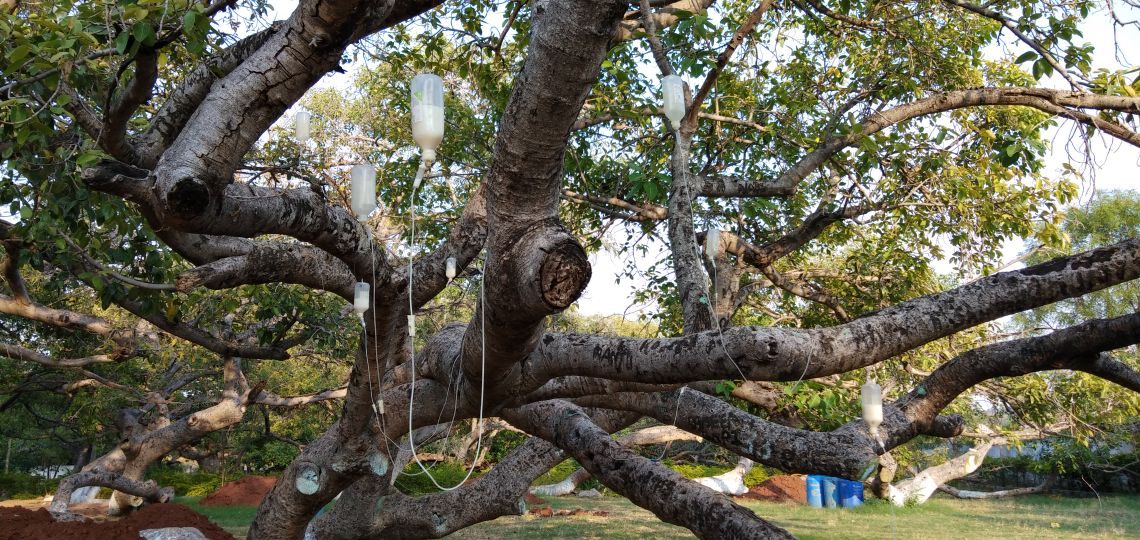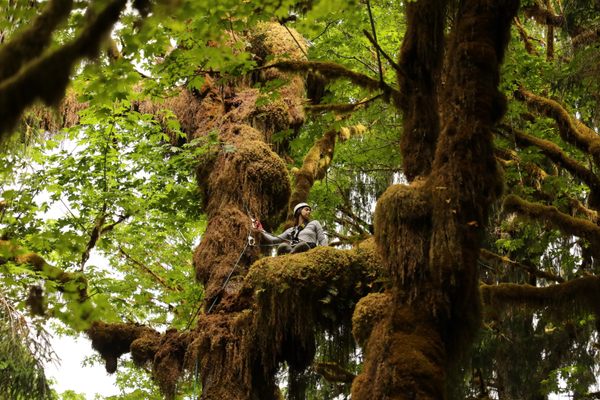A Dying 700-Year-Old Banyan Tree Was Brought Back to Life With an IV
It’s clinging to life drip-by-drip.

If the roughly 800-year-old banyan tree in Mahabubnagar, India, could talk, it would probably tell you the IV inserted in its branches is saving its life. Termites infested the tree, reportedly one of the oldest in India, and gradually chipped away at its wood until the poor banyan was near the brink of death. Last December, some of the tree’s branches fell down because of the infestation, resulting in officials closing the attraction to the public.
Known as Pillalamarri because of its many interweaving branches, the banyan tree measures 405 feet from east to west and 408 feet from north to south, according to Mahabubnagar District Forest Officer Chukka Ganga Reddy. The crown of Pillalamarri extends to 1,263 feet and the tree is spread across nearly four acres. Underneath the tree stands a small shrine that supposedly dates back to the year 1200, but the tree’s exact age is unclear. Nevertheless, calling the Ficus benghalensis a great banyan tree would be an understatement.
Such greatness attracts 12,000 tourists per year from every corner of the country to awe at its sheer vastness, but this tourism has also caused some troubles for the tree. According to Telangana Today, when Pillalamarri turned into a tourist attraction nearly a decade ago, the state government cut down branches and built concrete sitting areas around the tree for tourists. Tourists picked at the leaves, climbed on the branches, and carved names into the bark. Furthermore, to keep the area clean, the grounds team burned fallen leaves, which was bad for the soil. A recently installed dam on a neighboring stream restricted water flow to the tree.

Pillalamarri’s wider branches are now bending down to the ground instead of growing upwards, which gives floor critters, such as white ants and fungus, easier access to munch away. The termite infestation is yet one more problem weighing on Pillalamarri’s decaying, wooden shoulders. Officials initially injected the trunk with the pesticide chlorpyrifos, but saw no improvement. So they tried another method to prevent decay: hundreds of saline bottles filled with chlorpyrifos, inserted into Pillalamarri’s branches.
“This process has been effective,” Reddy told the Times of India. “Secondly, we are watering the roots with the diluted solution to kill the termites. And in a physical method, we are building concrete structures to support the collapsing heavy branches.” Telangana Biodiversity Board scientist G Sailu added that “the tree site cannot be declared as biodiversity heritage site as it is in reserve forest. The forest department shall give a heritage tree tag and conserve it.”
Despite the tree’s stable prospects, the public won’t be seeing Pillalamarri any time soon. When they do visit in the future, “this time people have to see it from a distance away from the barricades,” said Reddy. For now, drip-by-drip, the banyan tree’s health is returning to its former glory.



















Follow us on Twitter to get the latest on the world's hidden wonders.
Like us on Facebook to get the latest on the world's hidden wonders.
Follow us on Twitter Like us on Facebook